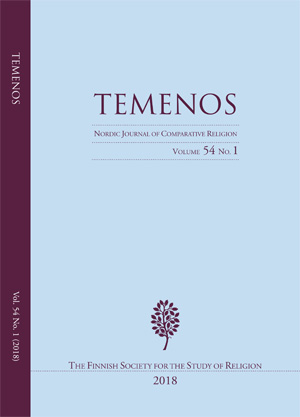Sheepskins, hair shirts and tunics of palm leaves
Charismatic authority and monastic clothing in Egypt in Late Antiquity
DOI:
https://doi.org/10.33356/temenos.73115Abstract
The theme is how authority is expressed in monastic clothes in late antiquity. The hypothesis is that different types of monastic garments speak to different types of authority, and that garments especially associated with charismatic authority came under scrutiny and criticism. The point of departure is Claudia Rapp’s tripartite explanatory model, which she uses to discuss the changing dynamics of authority in relation to Christian bishops. The focus in the present article is how monastic texts present charismatic authority by means of clothes. While a melote, sheepskin, tends to express a colonization of ascetic and charismatic authority, other items of clothing reflect charismatic authority more directly and untamed, such as the hair-shirt and the tunic of palm leaves.
Published
How to Cite
Issue
Section
License
Copyright (c) 2018 Temenos - Nordic Journal of Comparative Religion

This work is licensed under a Creative Commons Attribution-NonCommercial-NoDerivatives 3.0 Unported License.
Author's Guarantee
- The Author acknowledges that the Work will be publicly accessible on the Internet and that such access will be free of charge for the readers.
- The Author guarantees that the Work is her/his original work that has not been published before and cannot be construed as copying or plagiarism. Furthermore, the Author confirms that the Work contains no statement that is unlawful, defamatory or abusive or in any way infringes the rights of others.
- The Author confirms that she/he has secured all written permissions needed for the reproduction in the Publication of any material created by a third party.
User Rights
Under the CC BY 4.0 license, the Author/s and users are free to:
- Share — copy and redistribute the material in any medium or format,
- Adapt — remix, transform, and build upon the material for any purpose, even commercially,
- However, the Work must be attributed to the original Author and source of publication.
The license of the published metadata is Creative Commons CCO 1.0 Universal (CC0 1.0)
Author Rights
The Authors maintain the right to:
- copyright, and other proprietary rights relating to the Work,
- the right to use the substance of the Work in future own works,
- the right to self-archiving/parallel publishing (publisher's PDF allowed).
Rights of Publisher
- The Publisher reserves the right to make such editorial changes as may be necessary to make the Work suitable for publication in the publication, e.g. style of punctuation, spelling, headings and the like.
- The Publisher will publish the Work if the editorial process is successfully completed and reserves the right not to proceed with publication for whatever reason.
- The publication entitles the author to no royalties or other fees. This agreement will be governed by the laws of Finland.






